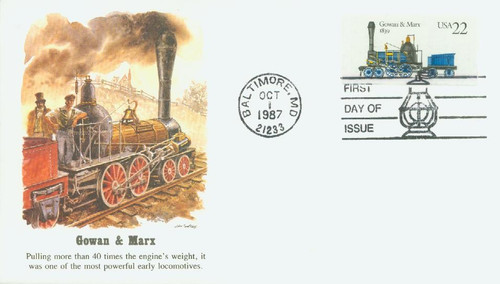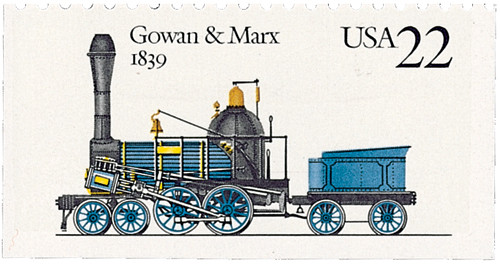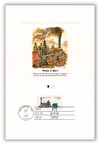
# 2366 - 1987 22c Steam Locomotives: Gowan & Marx
U.S. #2366
1987 22¢ Gowan & Marx
Steam Locomotives Booklet Pane
- Honors what was once the most powerful of all locomotives
- Issued at the Baltimore and Ohio Railroad Museum
- Issued for the 7th annual National Stamp Collecting Month
Stamp Category: Commemorative
Set: Steam Locomotives
Value: 22¢, first-class rate
First Day of Issue: October 1, 1987
First Day City: Baltimore, Maryland
Quantity Issued: 78,995,200
Printed by: Bureau of Engraving and Printing
Printing Method: Lithographed and engraved
Format: Four booklet panes of five stamps per booklet
Perforations: 10 horizontal on 1 or 2 sides
Why the stamp was issued: To pay tribute to the contributions of the different engines that sparked the railroad revolution in America
About the stamp design: Richard Leech based his stamp art on original illustrations of the locomotive.
First Day City: The First Day ceremony for this booklet was held at the Baltimore and Ohio Railroad Museum in Baltimore, Maryland.
About the Locomotives Booklet: Richard Leech was originally hired to design Locomotive stamps in 1979. His initial design was a block of four picturing the Stourbridge Lion, the Best Friend of Charleston, the Gowan & Marx, and the Jupiter. The Citizens’ Stamp Advisory Committee decided they wanted a booklet of five stamps and the Jupiter was removed and the John Bull and Brother Jonathan were added.
The 1987 Locomotives stamps were selected as that year’s annual National Stamp Collecting Month issue. Along with those stamps came the theme, “Steaming Along with Stamp Collecting. All Aboard!”
History the stamp represents: On February 20, 1840, the Gowan & Marx made an impressive run, hauling more than 100 cars weighing 423 tons. It was one of the earliest 4-4-0 locomotives with equalizing levers and became internationally known for hauling a train nearly 40 times its own weight.
The Gowan & Marx was built for the Philadelphia and Reading Company in 1839 by Eastwick and Harrison of Philadelphia. It was the 19th locomotive built by Eastwick and Harrison and was named for two the train’s investors and their London banking firm. Gowan & Marx had a short wheel base with its weight over the driving wheels and a large firebox and boiler. The 11-ton train was compact and powerful for its time, running about 147 horse power at its standard speed of eight to ten miles per hour.
Gowan & Marx had an oblong firebox, which resulted in a larger fire grate. It also had the feed-water pump in the cylinder saddle next to the cylinder, which was unusual at the time. With this design, the saddle was warmed by the steam going to and from the cylinder and prevented the pump from freezing. One of the train’s most notable features was its equalizing lever. Developed by Andrew Eastwick and Joseph Harrison and patented in 1838, this lever was crucial to evenly distributing the train’s load on the axles. This was particularly significant on poorly laid or uneven tracks. When completed, Gowan & Marx weighed 11 tons and had a 10-foot wheel base.
Gowan & Marx pulled the first train between Reading and Philadelphia on December 5, 1839. It then made its first runs in February 1840. The run on February 20 was of great interest to many. On that day, Gowan & Marx hauled a train of 101 four-wheel cars weighing 423 tons. It traveled at an average speed of 9.82 miles per hour, displaying an impressive tractive power (a way of measuring the train’s overall performance).
The Gowan & Marx’s impressive run attracted worldwide attention. The Russians sent two engineers to the US to report on the train’s performance. They were so impressed they invited Eastwick and Harrison to visit Russia and eventually struck a deal, leading Eastwick & Harrison to close their shop and move to Russia. By the time they left the US, they had built nearly 50 locomotives in America.
Initially, Gowan & Marx burned coal. However, it didn’t run well, so it used wood for a time. In 1855, the engine was converted to burn coal, but it still didn’t run properly. When Gowan & Marx was rebuilt in 1856, it weighed in at 13.8 tons. The redesign included the extension of the firebox so it could burn coal better.
Gowan & Marx operated for 20 years, covering over 144,000 miles. It was traded to Baldwin Locomotive Works, after which its final fate is unknown.
U.S. #2366
1987 22¢ Gowan & Marx
Steam Locomotives Booklet Pane
- Honors what was once the most powerful of all locomotives
- Issued at the Baltimore and Ohio Railroad Museum
- Issued for the 7th annual National Stamp Collecting Month
Stamp Category: Commemorative
Set: Steam Locomotives
Value: 22¢, first-class rate
First Day of Issue: October 1, 1987
First Day City: Baltimore, Maryland
Quantity Issued: 78,995,200
Printed by: Bureau of Engraving and Printing
Printing Method: Lithographed and engraved
Format: Four booklet panes of five stamps per booklet
Perforations: 10 horizontal on 1 or 2 sides
Why the stamp was issued: To pay tribute to the contributions of the different engines that sparked the railroad revolution in America
About the stamp design: Richard Leech based his stamp art on original illustrations of the locomotive.
First Day City: The First Day ceremony for this booklet was held at the Baltimore and Ohio Railroad Museum in Baltimore, Maryland.
About the Locomotives Booklet: Richard Leech was originally hired to design Locomotive stamps in 1979. His initial design was a block of four picturing the Stourbridge Lion, the Best Friend of Charleston, the Gowan & Marx, and the Jupiter. The Citizens’ Stamp Advisory Committee decided they wanted a booklet of five stamps and the Jupiter was removed and the John Bull and Brother Jonathan were added.
The 1987 Locomotives stamps were selected as that year’s annual National Stamp Collecting Month issue. Along with those stamps came the theme, “Steaming Along with Stamp Collecting. All Aboard!”
History the stamp represents: On February 20, 1840, the Gowan & Marx made an impressive run, hauling more than 100 cars weighing 423 tons. It was one of the earliest 4-4-0 locomotives with equalizing levers and became internationally known for hauling a train nearly 40 times its own weight.
The Gowan & Marx was built for the Philadelphia and Reading Company in 1839 by Eastwick and Harrison of Philadelphia. It was the 19th locomotive built by Eastwick and Harrison and was named for two the train’s investors and their London banking firm. Gowan & Marx had a short wheel base with its weight over the driving wheels and a large firebox and boiler. The 11-ton train was compact and powerful for its time, running about 147 horse power at its standard speed of eight to ten miles per hour.
Gowan & Marx had an oblong firebox, which resulted in a larger fire grate. It also had the feed-water pump in the cylinder saddle next to the cylinder, which was unusual at the time. With this design, the saddle was warmed by the steam going to and from the cylinder and prevented the pump from freezing. One of the train’s most notable features was its equalizing lever. Developed by Andrew Eastwick and Joseph Harrison and patented in 1838, this lever was crucial to evenly distributing the train’s load on the axles. This was particularly significant on poorly laid or uneven tracks. When completed, Gowan & Marx weighed 11 tons and had a 10-foot wheel base.
Gowan & Marx pulled the first train between Reading and Philadelphia on December 5, 1839. It then made its first runs in February 1840. The run on February 20 was of great interest to many. On that day, Gowan & Marx hauled a train of 101 four-wheel cars weighing 423 tons. It traveled at an average speed of 9.82 miles per hour, displaying an impressive tractive power (a way of measuring the train’s overall performance).
The Gowan & Marx’s impressive run attracted worldwide attention. The Russians sent two engineers to the US to report on the train’s performance. They were so impressed they invited Eastwick and Harrison to visit Russia and eventually struck a deal, leading Eastwick & Harrison to close their shop and move to Russia. By the time they left the US, they had built nearly 50 locomotives in America.
Initially, Gowan & Marx burned coal. However, it didn’t run well, so it used wood for a time. In 1855, the engine was converted to burn coal, but it still didn’t run properly. When Gowan & Marx was rebuilt in 1856, it weighed in at 13.8 tons. The redesign included the extension of the firebox so it could burn coal better.
Gowan & Marx operated for 20 years, covering over 144,000 miles. It was traded to Baldwin Locomotive Works, after which its final fate is unknown.










